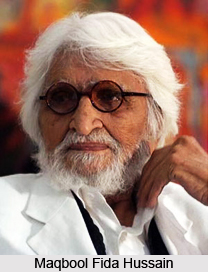 Maqbool Fida Hussain was born in Pandharpur, Maharashtra on September 17, 1915. He was often referred to as the Picasso of India. He got his primary education from Indore. He learned the art of calligraphy and practiced the Kulfic Khat with the geometric forms at an early age. In 1935 at the age of twenty he moved to Mumbai and was admitted to J.J.School of Arts for a year. This multifaceted genius had many other significant contributions as a film director, photographer, poet and member of the Indian Parliament.
Maqbool Fida Hussain was born in Pandharpur, Maharashtra on September 17, 1915. He was often referred to as the Picasso of India. He got his primary education from Indore. He learned the art of calligraphy and practiced the Kulfic Khat with the geometric forms at an early age. In 1935 at the age of twenty he moved to Mumbai and was admitted to J.J.School of Arts for a year. This multifaceted genius had many other significant contributions as a film director, photographer, poet and member of the Indian Parliament.
Career of Maqbool Fida Hussain
Hussain in 1937 started his career of painting huge cinema hoardings as a beginner to earn his livelihood. Hussain landed his entry in the sphere of Indian Art when his painting `Sunhera Sansaar` won an award in the Annual Exhibition of Bombay Art Society in 1947. In 1946, Francis Newton Souza invited Hussain to join Bombay Progressive Artists Group, a group formed to search a new dialect for Indian art. At this time he was exposed to the works of Emil Nolde and Oskar Kokoschka and it was their influence that led Hussain to paint the remarkable `Re Between The Spider And The Lamp`, `Zameen and Man`. The turning point of his career came when he visited Delhi and was encountered to ancient Mathura sculpture and Indian miniature paintings, which helped him to assimilate the ideas from oriental and occidental arts.
His first solo exhibition was conducted in Mumbai in1952. In 1954, Lalit Kala Akademi, New Delhi nominated M F Hussain as an eminent artist. Hussain has made several short films. He also made `Gajagamini` with Madhuri Dixit and `Meenaxi: A tale of Three Cities` with Tabu. Hussain has chosen different subjects of different aspects like British Raj on major cities such as Kolkata, Varanasi, Rome, Beijing; on the Epics- Mahabharata and Ramayana; a whole series on Mother Teresa, on the major nine religions of the world and a series on horses. He has made a big mural of 40 feet high named as `Portrait of the Twentieth Century`, which depicts all the major personalities of arts, science, dance, literature and politics. In 90`s Hussain painted an interesting series on cine artist Madhuri Dixit.
Hussain got recognition from Government of India for his immense contribution to the Indian art with the highest prestigious civilian awards like Padma Shri in 1966, Padma Bhushan in 1973 and the Padma Vibhushan in 1989. He was nominated to the Upper House or Rajya Sabha, the Indian Parliament in 1987 and during his six-year term he produced the Sansad Portfolio. At the age of 92 Hussain was to be given the prestigious Raja Ravi Varma award by the government of Kerala. In 1955 he won the national award at the Lalit Kala Academy`s first national exhibition.
This self-taught artist has defined and redefined the image of woman through his work. M F Hussain has become living-legend as the highest paid Indian artist ever. His fame rose up to the international level and a single painting of him could be sold at two million dollars. M.F.Hussain took citizenship of Qatar and surrendered his Indian citizenship after being long in exile.
He passed away on 9th June 2011 at the age of 95 years due to a heart attack.



















